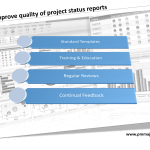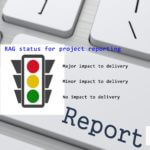A good project manager knows that the project status report is a great tool to communicate to senior stakeholders. Given the benefit, it is important that the project manager maximises the impact.
You organisation may or may not have a standard format for the report. Either way, there are 5 things that you must communicate.
RAG Status
The most widely used mechanism for reporting project status is RAG. This stands for Red, Amber, Green, with Green being on track and Red not on track. RAGs can be applied to the status of the overall project and the different dimensions i.e. budget, scope and schedule.
Typically the top of the report should contain a section to give the snapshot of status. To be even more helpful, include the change since the last reporting period as this then allows the audience to understand if the project has improved, deteriorated or remained unchanged.
Executive Summary
Every report must have a form of executive summary. This may also be termed Key Updates, Elevator Speech, etc. The purpose is to present the key messages for the update.
A good way to refine and target the update is to think, “if you only had 30 seconds to update your sponsor, what would you say?” Using this method should help focus your thinking to decide on the top 2 – 3 points you need to convey.
Do not try to squeeze every update for the project into the summary. This will only serve as information overload and risks the main messages being diluted.
Remember, senior sponsors typically have limited time. So if they only read the summary, make sure they go away with the top 2 – 3 points.
Achievements
This is different to the executive summary. This is used to provide more detail on what has been achieved since the last reporting cycle. While it may contain more detail, keep the update concise and try to use words that convey the benefits.
The achievements should support the executive summary.
Items Missed
This is where items that should have been delivered in the period have not been delivered. It is important to communicate these to manage expectations. The update should include the impact and what action is being taken to address, ideally with a date it will be resolved.
Risks / Issues
This may also go under the heading challenges, barriers, etc. The purpose is to convey what may or is impacting progress for the project. This is important as it may be that there are circumstances outside of the projects control that need to be addressed to get the project back on track. For example, where there is a resource dependency and senior management need to reprioritise a resource to work on the project.
It is also important to communicate the significant risks. Senior sponsors do not like surprises. Making sure they are aware of risks,, it means they are aware and then if they become issues, it is not a surprise. There may even be mitigating actions that the project manager recommends to be taken.
Additional Items
The 5 items listed above will form the basis of a good project status report. Additional information could be:
- Details of milestones
- Dependencies
- Resources
- Budget
- Benefits
The project status report is powerful. If you make sure that you focus on concise updates against these 5 areas, you will be able to communicate the key messages to your senior stakeholders.
Remember, less is more, especially when you need the audience to take action. When you review your report, aim to remove any words that are not really saying anything. This will ensure that the message is direct and to the point.






